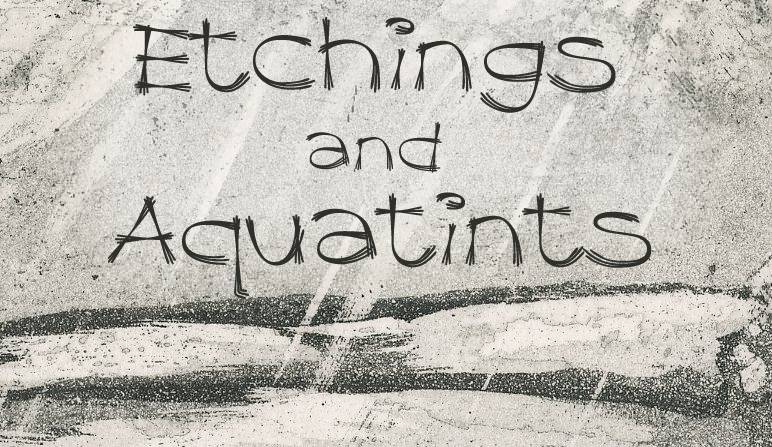What does Etching mean?
An Etching is a type of Original print. Etchings are images printed from metal plates that are etched with acid.
The word ‘etching’ is also used to describe the process of making the printing plate.
Aquatint is one of the methods used to make an etching and, when the word is used strictly, describes an etching produced using that method exclusively. People do also use the term when aquatint is the main method, but other methods are incorporated.
How etchings are made
The image is made directly on the printing plate, and this is what makes it an original print rather than a reproduction.
Acid is used to make the image on a metal plate. The areas that are intended to remain light are protected from the acid by various means using acid resistent coatings on the metal plate. The plate is immersed in acid and the unprotected areas are eaten away by the acid or ‘etched’.
Ink is held by the recesses and the image is produced by pressing the plate onto paper.
Yes, you guessed right! There’s a lot more to it.
This is not intended as a complete lesson in making etchings, but a description to help the curious to have some understanding of what they are looking at when they come accross a print made in this way.
Warning! Training is required in the use of acid – Don’t even think about doing this without training. Not even advisable to do it at home. Go to a printmaking class or supervised studio.
Variations in Line and Tone
These can be controlled to a high degree by the experienced printmaker. Many artists delight in an element of surprise when they make a final proof and others can be driven to distraction when it all goes ‘wrong’.
The type of protective coating and time the plate is immersed in the acid controls the intensity of the ink in the recesses on the plate and there are many ways of achieving the artist’s desired result.
The tones and lines are produced by varying the width and depth of the recessed areas. The width of the areas exposed to acid is controlled by the materials used to protect the metal and by the artist’s hand. The variation in the depth of line or texture is controlled by the length of time the plate is in the acid.
Enormous variation in tone and texture is possible in etching by using different methods of protecting the metal plate from the acid and exposing the plate to the acid.
The plate may be immersed numerous times and washed off as further work is done on the plate and the protective coating may be removed and a different kind used in stages of making.
There are several ways of achieving very diverse lines and textures in etching and it’s a long process.
If you want to understand how complex this process can be read this:
(Link to) Methods of Adding the Resist and Exposing the Metal
Printing the Image
Once the plate is complete, water resistent inks are pushed into the recesses, the excess removed and the plate is applied to the (damp) paper. A special soft blanket is added to the ‘sandwhich’ that allows the paper to be pushed into the recesses to ‘pick up’ the ink.
The plate, paper and blanket sandwich is passed through a heavy press, the paper carefully peeled off and allowed to dry.
The plate edge leaves an impression in the paper as well as the ink making it slightly 3d. This is part of the finished item and should allowed to be seen when framing for full appreciation.
Finally
Etchings are often limited editions and you can read more about that – I’ll add a link when I write the page
Meanwhile I’ll expand the info’ on making original prints
Here’s a video that shows one of the processes. It has an under age warning – probably because of the use of acid to make printing plates.
I saw nothing rude in it!

